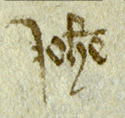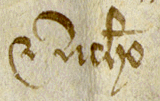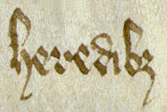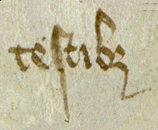| Contractions
|
 |
This is the common shorthand form of
et, 'and'. |
 |
This should be familiar as the Latin
abbreviation for nostra,'our'. |
 |
And this is the familiar nomen
sacrum domino, 'Lord', here used as a title for a priest.
I have translated it 'Sir', which was used in English at the time for members of the clergy. |
 |
A q with a stroke
through its descender followed by d stands for Latin
quod, 'that'. |
 |
This stands for the Latin
per. By itself it means 'through': it also appears in the words
super, 'above', nuper, 'previously, once',
and pertinencia, 'things appertaining, appurtenances'. |
 |
 |
 |
 |
The loop above the letter
t stands for er. This word is inter.
The words below are altera, 'other', seruicia, 'service',
and Iuner, 'joiner'. |
 |
 |
 |
 |
The p with a line
above it stands for Latin pre,'above, before'. Here it appears in the word
predictum, 'aforementioned', a frequent abbreviation in its own
right. Here the horizontal stroke over the word does not stand for a missing n
or m, but is a more general indication that the word has been contracted
(see below). |
 |
The same applies for this word, which is
quidem,'that'. |
 |
Other common contractions for whole
words are:
h followed by e with a line through the ascender
of the h, standing for various forms of the verb habere, 'to have'.
This one is habendum, 'to have'. |
 |
Cl with a line through the l, standing for cler.
Here the word is clerico, 'cleric, clerk'. |
 |
This is secundo, 'second'. |
Names are usually abbreviated merely by marking them with a straight horizontal line.
Below we have Willelmo, 'William',
Iohanne, 'John', and Nicholao, 'Nicholas'. |
 |
 |
 |




























